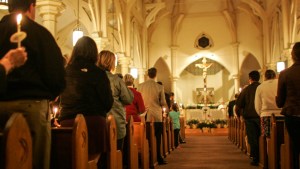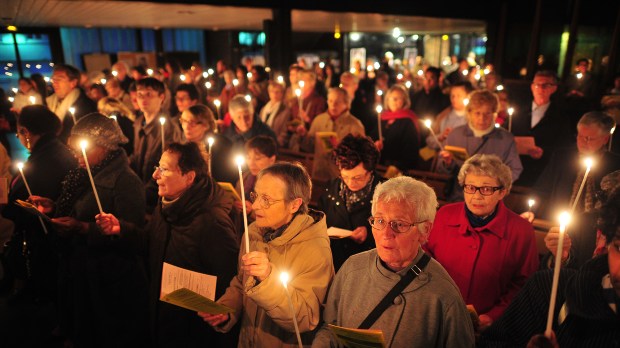Holy Week is the holiest week of the year in the Catholic Church, and its unique character is reflected in the liturgy. The Mass is celebrated differently and there are other liturgical traditions that help us become immersed into the events of Jesus’ Passion, death and resurrection.
Many of these traditions find their roots in the early Church, as Christians sought ways to relive these events on an annual basis.
Here is a short list of 7 particular traditions of Holy Week in the Roman Rite of the Catholic Church.
Please click the titles below to learn more information about them.
Why do Catholics cover crucifixes and statues during Holy Week?
While it may appear counterintuitive to veil statues and images during the final weeks of Lent, the Catholic Church recommends this practice to heighten our senses and build within us a longing for Easter Sunday. It is a tradition that should not only be carried out in our local parish, but can also be a fruitful activity for the “domestic church” to practice.
The rubrics can guide us. In the Roman Missal we find the instruction, “In the Dioceses of the United States, the practice of covering crosses and images throughout the church from [the fifth] Sunday [of Lent] may be observed. Crosses remain covered until the end of the Celebration of the Lord’s Passion on Good Friday, but images remain covered until the beginning of the Easter Vigil.”
Can you stay one hour with me? The “Night Watch” of Holy Thursday
Often the Eucharist is placed in a secondary tabernacle on a side altar, or in an area of the church that is most suitable. This procession from the main altar to another location in the church is symbolic of the movement of Jesus to the Garden of Gethsemane, where he experiences great agony before his arrest and betrayal.
The Roman Missal explains what should take place after placing the Eucharist in this new location.
The faithful are invited to continue adoration before the Blessed Sacrament for a suitable length of time during the night, according to local circumstances, but after midnight the adoration should take place without solemnity.
This tradition of adoring Our Lord in the Blessed Sacrament on Holy Thursday is often called the “Night Watch” or “Gethsemane Watch” and recalls how Jesus invited his apostles to stay with him while he prayed.
Why is there no Mass and only a “service” on Good Friday?
One of the most fascinating days in the liturgical calendar is Good Friday. On the day that honors the Passion and death of Jesus, the Church abstains from offering a Mass.
Instead, the Church instructs its believers to host a “Celebration of the Lord’s Passion,” which includes a special reading of the Gospel, the veneration of the cross and the distribution of Holy Communion from the reserved Sacrament.
St. Thomas Aquinas offers in his Summa Theologica one explanation as to why the Mass is not offered. He states that, “The figure [the Mass] ceases on the advent of the reality. But this sacrament is a figure and a representation of our Lord’s Passion, as stated above. And therefore on the day on which our Lord’s Passion is recalled as it was really accomplished, this sacrament is not consecrated.”
“My people, what have I done to you?” The Reproaches of Good Friday
During the Good Friday liturgy there is a time when all those present are invited to approach the altar and reverence the crucifix with a kiss, touch or genuflection. It can be an emotional part of the liturgy as the faithful are brought to the foot of the cross and feel the sorrow of Good Friday.
To highlight the mournful atmosphere, the Church provides an optional hymn that can be sung during the adoration of the Holy Cross. It is traditionally called the “Reproaches” (Improperia in Latin) and presents Jesus’ sorrow on the cross.
Into the darkness of Good Friday: The ancient liturgy of Tenebrae
One of the many beautiful liturgies of Holy Week, which does not always receive much notice, is the liturgical service called Tenebrae.
The Latin name is translated as “darkness,” and it is a liturgy celebrated by Roman Catholics as well as Anglicans, Protestants and some Orthodox Churches.
Essentially it consists of chanting the Liturgy of the Hours on the final three days of Lent. The liturgical hours of Matins and Lauds (Office of Readings and Morning Prayer) for Holy Thursday, Good Friday and Holy Saturday are typically anticipated the evening before and celebrated in candlelight.
The early Church abstained from Mass on Holy Saturday
historians believe that Holy Saturday was also a day that did not have a Mass. Instead, Christians held an all-night vigil that started in the middle of the night on Saturday and didn’t end until the first rays of dawn when the celebration of Mass began on Easter morning.
Author Herbert Thurston gives a brief explanation in his book, Lent and Holy Week.
[T]he Mass which is now sung on Holy Saturday … was not originally a Mass for Holy Saturday at all, but coming at the end of the long ceremonies of the great vigil, was in reality the midnight Mass of Easter Sunday. Probably in the earliest stage of the celebration this point was not reached until long after midnight, when the day was already beginning to break. There was every reason then why the joyous exultation of the Resurrection should find its first expression there. Theoretically Holy Saturday, like Good Friday, was an ‘aliturgical’ day, a day without a Mass.
The liturgy was eventually shortened and pushed back earlier in the evening, becoming the Easter Vigil that we celebrate today.
Here’s a step-by-step guide to the Easter Vigil
The entire liturgical year culminates in the Easter Vigil, an ancient liturgy celebrated on the night before Easter Sunday. It was initially an all-night vigil that started in the middle of the night and didn’t end until the first rays of dawn, when the celebration of Mass began.
For early Christians, it was a way to welcome the rising of the Son of God, who dispels the darkness of night.
It was eventually shortened and pushed back earlier in the evening, but many of the same rituals are performed with great solemnity. The Easter Vigil is a beautiful experience, one that immerses a person into the very heart of the Paschal mystery.
Click here for the complete guide.

Read more:
Here’s a step-by-step guide to the Easter Vigil

